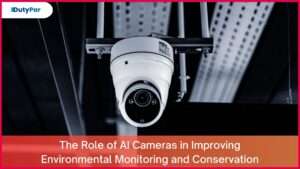 In recent years, environmental monitoring and conservation have become critical concerns for scientists, policymakers, and the general public. The effects of climate change, habitat destruction, and human activities have had a significant impact on our planet’s biodiversity. As such, innovative technologies like AI cameras are now playing a pivotal role in addressing these challenges.
In recent years, environmental monitoring and conservation have become critical concerns for scientists, policymakers, and the general public. The effects of climate change, habitat destruction, and human activities have had a significant impact on our planet’s biodiversity. As such, innovative technologies like AI cameras are now playing a pivotal role in addressing these challenges.
In this article, we’ll explore the role of AI cameras in improving environmental monitoring and conservation and how they are revolutionizing the way we study and protect our planet’s ecosystems.
Understanding AI cameras
AI cameras are devices equipped with advanced sensors and algorithms that can process images and detect patterns in real-time.
They are part of a broader category of technologies known as remote sensing, which refers to the collection and analysis of data from a distance.
AI cameras are commonly used for surveillance, security, and law enforcement, but their potential for environmental monitoring and conservation is immense.
AI Cameras in Environmental Monitoring
One of the most significant benefits of AI cameras is their ability to provide real-time data on wildlife populations and their behavior. This information is critical for researchers and policymakers to make informed decisions about conservation efforts. AI cameras are used to monitor animal movements, breeding patterns, and habitat use, among other things.
AI cameras can also detect changes in the environment, such as deforestation, erosion, and water pollution. This information can help scientists understand the impact of human activities on ecosystems and make recommendations for mitigating their effects.
AI Cameras in Conservation
AI cameras are also being used to identify and track endangered species, such as rhinos, tigers, and elephants.
This information is critical for conservation efforts, as it enables researchers and policymakers to understand the species’ behavior, habitat, and movement patterns.
This data can then be used to develop effective conservation strategies, such as habitat restoration, anti-poaching efforts, and wildlife corridors.
AI cameras are also used to monitor invasive species, which can have a significant impact on native ecosystems. By detecting and tracking invasive species, scientists and policymakers can develop strategies to mitigate their impact and protect the biodiversity of the ecosystem.
Benefits of AI Cameras in Environmental Monitoring and Conservation
There are several benefits to using AI cameras for environmental monitoring and conservation, including:
● Cost-effective: AI cameras are more cost-effective than traditional monitoring methods, such as satellite imagery and on-the-ground surveys.
● Real-time data: AI cameras provide real-time data, allowing researchers and policymakers to respond quickly to changes in the environment.
● Non-invasive: AI cameras are non-invasive, meaning they don’t disrupt wildlife or their habitats.
● High accuracy: AI cameras are highly accurate, detecting patterns that might be missed by the human eye.
● Scalability: AI cameras can be scaled up or down depending on the needs of the study or conservation effort.
Challenges of AI Cameras in Environmental Monitoring and Conservation
Despite their many benefits, AI cameras also pose several challenges, including:
● Data management: AI cameras generate a significant amount of data, which can be challenging to manage and analyze.
● Privacy concerns: AI cameras can be used for surveillance and raise privacy concerns for individuals living near protected areas.
● False positives: AI cameras can sometimes generate false positives, mistaking one species for another or detecting movement where there is none.
● Maintenance: AI cameras require regular maintenance and can be vulnerable to damage from weather or wildlife.
Conclusion
AI cameras have the potential to revolutionize environmental monitoring and conservation efforts. They provide real-time data on wildlife populations, habitat use, and environmental changes, enabling researchers and policymakers to make informed decisions about conservation efforts. However, they also pose several challenges, including data management, privacy concerns, false positives, and maintenance. As technology advances, these challenges will be addressed, and AI cameras will become even more powerful tools in the fight to protect our planet’s biodiversity.
